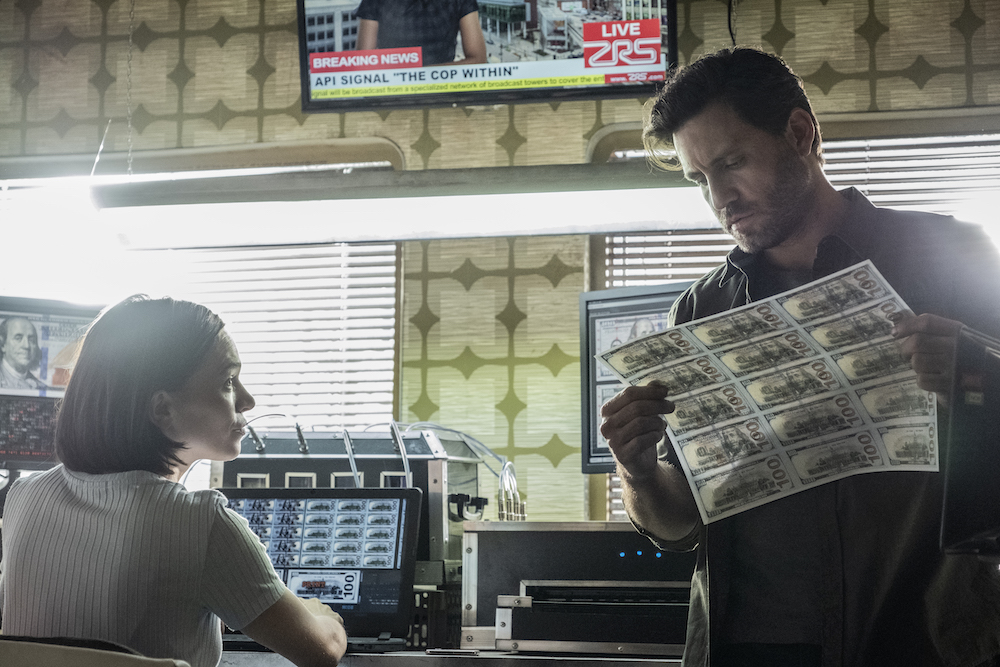It’s fascinating how Netflix movies continue landing on 2020 release dates where they feel especially relevant to the moment. The Spanish horror-satire The Platform, which imagines an experiment where limited food is apportioned between hungry captives held in a concrete prison, debuted on the streaming service just as society was fighting over its own limited resources in the early days of quarantine. Now, a movie that envisions the future of policing comes to Netflix as the United States, even some places here in Australia, are being torn apart by clashes between protesters and police, which have focused on ways law enforcement could be more humane and race blind.
If only The Last Days of American Crime did more with its engaging premise. It’s 2025, and the Powers That Be have invented a signal that will broadcast from the equivalent of regional mobile phone towers, to inhibit criminals before they have the chance to break the law. This signal renders them unable to engage in any behaviour they know to be unlawful, and it’s predicted to revolutionise law enforcement. In fact, as the signal goes live, police are preparing to cede control to the project known as API, which means turning over their weapons and finding other lines of work. In the week leading up to the handover, not only are protestors demonstrating against this move to a police state, but criminals are trying to get their last licks on anything resembling one final score. Needless to say, it’s a chaotic world, and uniformed police officers are caught in the middle.
Three particular criminals have one epic swan song in mind, hoping to escape across the border to Canada with their ill-gotten gains, where they can actually spend it, rather than being left criminally impotent by the API signal. The first is a rogue loner known by his surname, Bricke (Edgar Ramirez), who has made a lot of powerful enemies in his day. He falls under the spell of Shelby (Anna Brewster), a femme fatale who seduces him in a bar. Turns out she’s actually on a scouting mission from her boyfriend Kevin (Michael Carmen Pitt), the son of an organised crime boss, who has hatched the scheme.
If all goes according to plan, and using Shelby’s hacker skills, they will be able to take advantage of a short window in the handover to disrupt API’s signal. During that time, they plan to steal $1 billion in new and old money from the “money factory,” where they create new notes and destroy old ones. Kevin just wants to commit the legendary last crime on American soil, but Bricke has a different mission in mind – revenge for the death of his brother, who was killed in prison under suspicious circumstances.
Director Olivier Megaton chose his artistic nom de plume as a result of being born 20 years to the day after the bombing of Hiroshima. It has also been a good metaphor for the types of movies he’s made: as loud and as dumb as possible. That includes two Taken sequels and a Transporter sequel. On its surface, The Last Days of American Crime seems to keep those career preoccupations in clear focus while making a step in the direction of more prestigious, high-concept fare. As it plays out, though, the film’s sci-fi elements take a back seat to its ordinary crime movie execution. Part of this is confusion about what the signal actually is.
There would be something low-key frightening about a technology that effectively brainwashes its people, turning them into compliant robots for the apparent betterment of society. That’s not what this is. When we see the signal deployed in short bursts, it seems to actually cripple anyone within range, so not only can they not fire a gun or rob an old lady of her purse, but they actually can’t move at all. It also looks like it causes a major headache. There’s no satisfactory explanation how this could work as the universal default condition, without bringing American society to a complete standstill.
The narrative is sloppily constructed. Certain scenes have a compelling momentum, but interspersed with them are entire 15-minute diversions that have nothing to do with moving the story forward. That can happen when a movie is 2 hours and 30 minutes long. (Oh, did I forget to mention that?) One whole section where they visit Kevin’s crime boss father (Patrick Bergin, unearthed from Lord knows where) seems to serve no narrative purpose other than giving Michael Pitt more of a chance to chew scenery.
Which brings us to one of the film’s true pleasures. Every time Pitt is on screen, he is a joy to watch. With his preening and his outrageous succession of designer jackets, he constantly draws your eye, especially the more desperate your eye becomes for entertainment. He injects an electroshock of personality into every sequence, and what’s more, feels like he has mapped out a real character here. That’s in direct contrast to the film’s protagonist, played by Edgar Ramirez. Bricke is his name, but it could also describe Ramirez’ emotional range as an actor. Anna Brewster splits the difference between the two.
In terms of the Netflix “more is more” approach to giving artists creative control, it backfires in a particularly curious way here. Even with all that screen time at their disposal, Megaton and screenwriter Karl Gajdusek (adapting the graphic novel of the same name) basically abandon their most interesting theme, the impact of this technology on policing. They’ve bothered to give this theme a face with a character on the police force, played by possibly the film’s most famous performer: South African star Sharlto Copley. Then they haven’t done anything with him. Introduced at the start, Copley disappears for more than an hour before resolving in a total non-payoff. That’s a pretty good descriptor for the movie on the whole.



